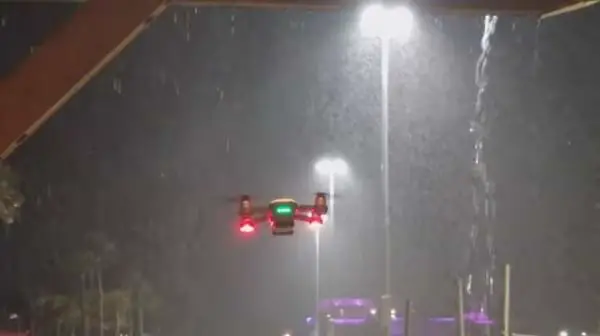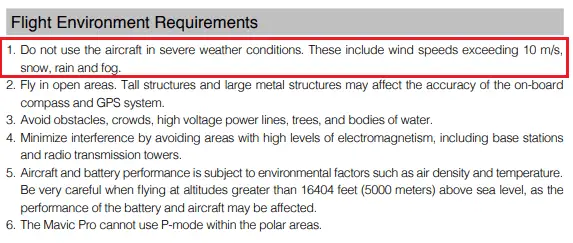
There’s a very real risk that your drone will get caught out in the rain especially if you fly out far, and if you live in a rainy area.
Drones can’t fly in the rain if they are not advertised as being waterproof or watertight. Drones have very sensitive electronic components that will short circuit if any raindrops come in touch with them. This can cause serious damage that might not happen instantly, but will definitely happen over time.
If you’re tempted to fly in the rain or it already happened by mistake, keep reading to find out what you can expect.
What Exactly Happens If A Drone Flies In The Rain?
Initially, nothing will happen. Your drone will fly through the rain without any problems. It might even leave you thinking that your drone might be waterproof. However, don’t! It instantly voids your warranty and the real damage happens later down the line. All it takes is a few drops to begin corroding at any of the electronic components which will slowly start messing up your drone.
Here is a likely scenario.
- You fly your drone in the rain without any problems.
- Raindrops or dew begin corroding away at the electronics, which could lead to a short circuit.
- Mist begins to appear in the cameras, which ruins the camera and footage.
- Corrosion begins to cause tiny short circuits, then different components of the drone begin to fail.
- During your next flight you notice that the drone “feels offish.”
- The condition of your drone begins to degrade, until one day it doesn’t fly at all.
- Your drone dies, and your warranty is void.
That’s a very likely scenario, especially if you’re flying in heavy rain. You wouldn’t use your laptop in the rain would you, so don’t intentionally use your drone in the rain.
If you already flew your drone in the rain, then I HIGHLY recommend you go through this guide that will show you how you can fix a water damaged drone quickly. Do it as soon as possible to avoid any further damage.
Is My Drone Waterproof or Water-resistant?
By definition, a waterproof drone means that it is watertight. So it won’t allow any water to pass through any of the electronic components. Drones that are waterproof are able to fly through heavy rain, and can even be submerged in water.
On the other hand, water-resistant means that the electronic device is able to block off only some water such as splashes, or raindrops, however, it won’t be able to be fully submerged.
Chances are if you don’t know if your drone is waterproof or Watertight then it’s probably not. Drones that are waterproof advertise this feature heavily because it’s so unique.
However, if you want to make sure, the quick way to know is to have a look inside your drone’s manual. The manual should show you exactly what weather conditions you can fly your drone in.
For example below is a snapshot of the DJI Mavics manual. Notice that it advises against flying in any kind of rainy conditions.

Now keep in mind that this doesn’t mean that you can’ fly in light rain, for example, the drone probably could. However, if you do get any water damage, then it won’t be covered by the warranty.
How To Check How Much Water Your Drone Can Withstand
Your drone should have an IP rating, (International Protection Marking, IEC standard 60529,) either in the manual or on the body of the drone. This code is the international standard that records the amount of protection the electronic components have from either small particles such as dust and water, as well as from contact that happens accidentally and intrusion.
The code published by the International Electrotechnical Commission became an international standard because it gives buyers more in-depth information on the very vague waterproofing summaries that are usually given to us by drone manufacturers. I mean that’s exactly why you’re reading this is the first place right? You have no idea how much your drone can withstand.
So what exactly do the numbers mean and how can you find your drones IP rating?
The code generally has two numbers after the IP code. So for example, imagine that your drones IP code is IP35.
The first number, “3,” explains the protection against solid particles. Since we’re trying to figure out the drones against liquid, we will ignore that one for now.
The second digit, “5,” is designed to show the drones built-in protection against liquid. There are 12 different levels of protection against liquid. View the table below.
| Second Digit/Number: | Protected against: | Effective against: | Details of test: | Example: |
| X | – | – | This means that there is no data available. | IP3X |
| 0 | No protection. | Nothing. | No test. | IP30 |
| 1 | Dripping water. | Vertically water dripping onto the electronic device while rotating at 1 RPM. | Test was done for 10 minutes with 1mm rainfall per minute. | IP31 |
| 2 | Dripping water when tilted at 15° | Vertically dripping water while electronic object is tilted at 15°, Four positions were tested with two axis. | Total of 10 minutes performed, 20m30s for each direction. Used 3mm of rainfall per minute. | IP32 |
| 3 | Water spraying. | Water is falling at 60° from vertical as a spray. | Test lasted for 1 minute per square meter for a minimum of 5 minutes. Water volume is 10 litres per minute. | IP33 |
| 4 | Water splashing. | Water splashing from any direction. | Test lasted for at-least 10 minutes using a oscillating tube. | IP34 |
| 5 | Water jets. | Water jetted against an enclosure. | Test lasts at-least 3 minutes with 12.5 litres per minute. | IP35 |
| 6 | Powerful water jets. | Water jetted with more power against enclosure. | Test lasts at-least 3 minutes with 100 litres per minute. | IP36 |
| 6K | Powerful water jets with increased pressure. | Water jetted with even more power against enclosure. | Test lasts at-least 3 minutes with 75 litres per minute. | IP36K |
| 7 | Immersion, up to 1 meter (3 ft 3 in) depth. | Electronic device can be fully immersed under water up to 3 feet and 3 inches. | In the test the device was immersed for 30 minutes. | IP37 |
| 8 | Immersion, 1 meter (3 ft 3 in) or more depth. | Can be fully immersed for a longer period of time. Exact amount decided my manufacturer. | Tested for duration decided by manufacturer. | IP38 |
| 9K | Powerful high-temperature water jets. | Protected against high pressure and high temperature water. | Test lasts for a minimum of 3 minutes with water temperature of 80 °C (176 °F) | IP39K |
Where can you find the international protection rating on your drone?
- Check the box, drone body, or manual. The international protection code for your drone can either be located on the drone’s body, on the box or in the manual.
- You can google it. For example, I googled “DJI Matrice 200 IP rating,” and here is what I got back; IP43. Based on the graph above, this means that the DJI Matrice can withstand spraying water at 10 liters per minute for 5 minutes.
- Website. Most drone manufactures will have this information displayed on the website.
- Call customer support. As a last resort, if you can’t find the rating, you can also phone the manufacturer’s customer support.
How To Water-Proof Your Drone
If you live in an area where it’s constantly raining then you’ll probably want to try waterproof your drone. This might even a good idea if you fly out over far distances, and you’re worried about getting caught in the rain.
There are a few options you have.
- Buy some drone conformal silicone coating.
- Get some drone wet-suites. For example, here’s a Phantom 4 wet-suite.
Just keep in mind that because of the added weight, this will affect your drones range, flight stability and battery life. On the DJI forum, a drone pilot mentioned that he lost around 2 to 3 minutes of flight time while using one of these wet suites which isn’t that bad considering it could save your drones life.
13 Best Water Proof Drones
- The Matrice 200 series
- SwellPro Splash Drone 3 Fisherman
- PowerVision PowerEgg X
- JJRC H31 Waterproof Drone
- QuadH2O
- Parrot Hydrofoil
- SwellPro Spry Drone
- HexH2O Pro V2
- Goolsky Q353 Triphibian Quadcopter
- Goolsky IDEAFLY Poseidon
- Eachine Waterproof Hovercraft Toy
- LiDiRC L15FW Waterproof Quadcopter
- Rigel7 JJRC 3-in-1 Waterproof Hovercraft
